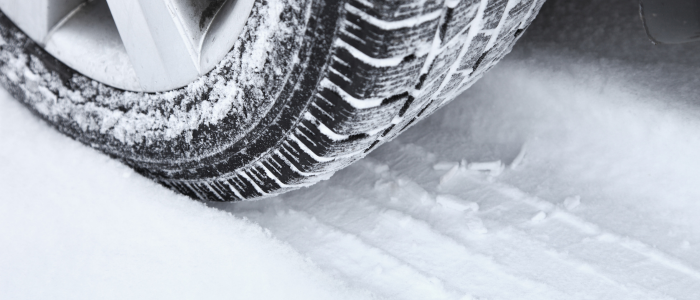
Winter Tyres – Everything You Need to Know
With the shortening of days and the descent of temperatures, winter's icy grip begins to tighten its hold on our roads. Whether you live in a region that's no stranger to snow and ice or you're preparing for a winter road trip, one essential consideration can make a significant impact: winter tyres.
Winter tyres, also known as cold-weather tyres, are a crucial component of your vehicle's seasonal readiness. But do you know all there is to know about winter tyres? Are you aware of their benefits, how they differ from regular tyres, and when you should consider making the switch? In this comprehensive guide, we'll delve into everything you need to know about winter tyres. From understanding the science behind their design to exploring the advantages they offer; we’ve got you covered.
What are winter tyres?
Winter tyres are a specialised type of tyre designed to provide superior traction, control, and safety in cold weather conditions, particularly during the winter months. These tyres are engineered to perform optimally in temperatures below 7°C and are specifically crafted to handle various winter challenges, including snow, ice, slush, and wet roads.
It's important to note that winter tyres are not just for areas with heavy snowfall; they are also beneficial in regions where temperatures consistently drop below 7°C. Even without significant snow, these tyres provide superior performance and safety in cold, wet, or icy conditions.
How do winter tyres work?
Winter tyres have deeper tread patterns compared to regular or all-season tyres. This depth allows the tyre to bite into snow and slush, providing better traction. Additionally, winter tyres feature a higher density of sipes, which are small slits or grooves in the tread blocks. Sipes create additional biting edges that grip the road surface and improve traction on icy and wet roads. The tread blocks on winter tyres are often designed to be blockier and chunkier, which enhances stability and grip on snow and ice.
Furthermore, the rubber compound used in winter tyres is formulated to remain flexible even at extremely low temperatures. Regular tyres tend to harden in cold conditions, reducing their grip, but winter tyres stay pliable, ensuring a firm grip on the road. Overall, winter tyres provide shorter braking distances on snow and ice, thanks to their superior traction. They also offer better handling and control in slippery conditions, allowing drivers to navigate safely.
In some regions with extreme winter conditions, drivers opt for studded winter tyres. These tyres have metal studs embedded in the tread, which further improves traction on icy surfaces. However, studded tyres may not be legal or necessary in all areas, and they can damage road surfaces, so they are subject to restrictions in many places.
How much are winter tyres?
The cost of winter tyres in the UK can vary broadly based on numerous factors such as the brand, tyre size, and where you purchase them. On average, you'd typically pay between £50 to £150 or more per winter tyre. While budget winter tyres may be more affordable, investing in higher-quality tyres can offer better performance, durability, and safety in winter conditions. As well, new winter tyres are more expensive than used ones, but buying new tyres ensures that you get the full benefit of the tyre's performance and safety features.
Additionally, keep in mind that you'll need to purchase a set of four winter tyres for optimal performance and safety. Using only two winter tyres on the front or rear of your vehicle can lead to imbalanced handling and reduced control.
When should I change to winter tyres?
The timing for changing to winter tyres depends on your location, the local climate, and the specific weather conditions you anticipate. The primary factor in deciding when to switch to winter tyres is the temperature. Winter tyres are designed to perform optimally at temperatures below 7°C. As temperatures drop and stay consistently below this threshold, it's a good time to consider changing to winter tyres. As well, in many regions, the transition to winter tyres aligns with the changing of the seasons. This often means switching to winter tyres in the late autumn or early winter months when cold weather becomes prevalent.
Furthermore, assess the state of your winter tyres from the previous season, if relevant. Make sure they have adequate tread depth and are free from any damage. Should you find signs of wear or damage, it's important to consider their replacement. Keep in mind that winter tyres may become scarce or more expensive as the demand increases closer to the winter season. Plan ahead to avoid potential shortages and higher prices.
How long do winter tyres last?
The lifespan of winter tyres can vary depending on several factors, including the tyre's quality, your driving habits, road conditions, and how well you maintain them. On average, winter tyres can last anywhere from two to six winter seasons. Premium winter tyres from reputable manufacturers tend to have a longer lifespan than budget options. Moreover, rough or poorly maintained roads can lead to faster tyre wear.
Remember that maintaining proper tread depth and tyre condition is essential for your safety during winter driving. Worn-out winter tyres can significantly reduce their effectiveness on snow and ice, increasing the risk of accidents. When in doubt, prioritise safety and replace your winter tyres if they show signs of significant wear or if they have reached their recommended lifespan.
What pressure should winter tyres be set to?
The recommended tyre pressure for winter tyres remains consistent with that of your vehicle's regular tyres. The most precise and reliable source for finding the correct tyre pressure is your vehicle's owner's manual. It will provide you with the manufacturer's recommended tyre pressure for both front and rear tyres. Alternatively, many vehicles feature a sticker on the driver's side door or the inside of the fuel filler flap that shows key information such as the recommended tyre pressure. It's important to note that the recommended tyre pressure may fluctuate upon the vehicle's make, model, and tyre size, so it's important to use the correct specifications for your particular vehicle.
Additionally, when it comes to maintaining tyre pressure for winter tyres, there are some key considerations. First, tyre pressure can drop in cold weather, so it's essential to check and adjust your tyre pressure when the tyres are cold. Driving heats up the tyres, which can give a false reading. Also, some drivers choose to slightly increase tyre pressure in their winter tyres to compensate for the lower temperatures. However, this should only be done within the manufacturer's recommended range. Check your tyre pressure regularly throughout the winter season to ensure it remains within the recommended range.
What is the min. tread depth for winter tyres?
Winter tyre treads feature deeper grooves, allowing them to collect snow and slush within their channels. Interestingly, snow actually enhances grip on snow-covered surfaces, making these deep treads highly effective in providing traction. Consequently, it's essential to replace winter tyres before their tread depth reaches the legal minimum of 1.6mm. Experts recommend getting a fresh set of winter tyres when the tread depth hovers around 4mm.
Winter Tyres vs. Summer Tyres
When it comes to your vehicle's tyres, one size does not fit all, especially when considering the differences between winter tyres and summer tyres. These two types of tyres are engineered with distinct features to perform optimally in specific weather conditions.
First, summer tyres have a shallower tread pattern with fewer sipes. As well, summer tyres are made from a rubber compound optimised for warm temperatures. Summer tyres also excel in temperatures above 7°C. They offer peak performance on warm and dry roads but may lose traction and wear out quickly in cold weather. In summary, the choice between winter tyres and summer tyres depends on the climate and seasonal conditions in your area.
Many drivers also opt for all-season tyres, which provide a compromise between winter and summer tyre characteristics and can be used year-round in moderate climates. All-season tyres feature a tread pattern that offers moderate traction on dry, wet, and lightly snowy surfaces. While they lack the deep treads and cold-weather rubber compounds of winter tyres, and the high-performance capabilities of summer tyres, their convenience lies in being a year-round solution for drivers.
Are winter tyres a legal requirement in the UK?
In the UK, winter tyres are not legally required, so this is completely down to your choice. Nevertheless, opting for winter or all-season tyres during the winter months can be a safer choice for driving in adverse weather conditions. Some UK motorists choose to fit winter tyres during the winter months for enhanced control and performance.
As we bring our exploration of winter tyres to a close, we hope you have found this article interesting and informative. If you enjoyed reading this, keep informed about our latest special offers and updates by visiting our Facebook page
Latest Posts

Discover Your Perfect Halloween Car Match
Find Your Halloween Ride: Which Spooky...

Jeep Avenger Review 2024
Meet the Jeep Avenger, the brand’s...

A Comprehensive Kia Stonic Review
See for yourself if this could...

Cheap Vans to Lease 2024
Let's explore some of the cheapest...

Exploring Excellence: Isuzu D-Max Review 2024
In this Isuzu D-Max review, we'll...


































